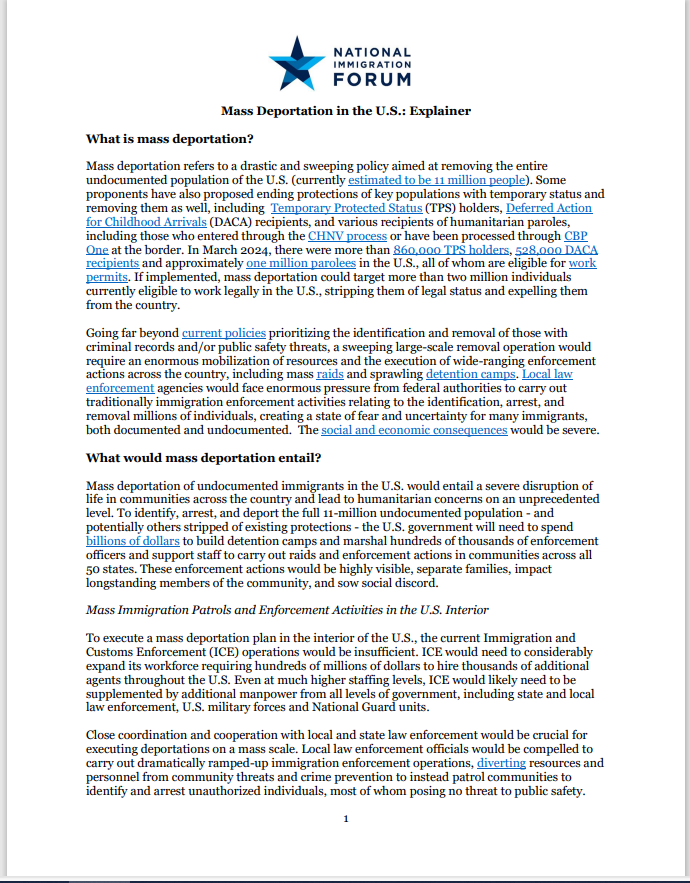
What is mass deportation?
Mass deportation refers to a drastic and sweeping policy aimed at removing the entire undocumented population of the U.S. (currently estimated to be 11 million people). Some proponents have also proposed ending protections of key populations with temporary status and removing them as well, including Temporary Protected Status (TPS) holders, Deferred Action for Childhood Arrivals (DACA) recipients, and various recipients of humanitarian paroles, including those who entered through the CHNV process or have been processed through CBP One at the border. In March 2024, there were more than 860,000 TPS holders, 528,000 DACA recipients and approximately one million parolees in the U.S., all of whom are eligible for work permits. If implemented, mass deportation could target more than two million individuals currently eligible to work legally in the U.S., stripping them of legal status and expelling them from the country.
Going far beyond current policies prioritizing the identification and removal of those with criminal records and/or public safety threats, a sweeping large-scale removal operation would require an enormous mobilization of resources and the execution of wide-ranging enforcement actions across the country, including mass raids and sprawling detention camps. Local law enforcement agencies would face enormous pressure from federal authorities to carry out traditionally immigration enforcement activities relating to the identification, arrest, and removal millions of individuals, creating a state of fear and uncertainty for many immigrants, both documented and undocumented. The social and economic consequences would be severe.
What would mass deportation entail?
Mass deportation of undocumented immigrants in the U.S. would entail a severe disruption of life in communities across the country and lead to humanitarian concerns on an unprecedented level. To identify, arrest, and deport the full 11-million undocumented population – and potentially others stripped of existing protections – the U.S. government will need to spend billions of dollars to build detention camps and marshal hundreds of thousands of enforcement officers and support staff to carry out raids and enforcement actions in communities across all 50 states. These enforcement actions would be highly visible, separate families, impact longstanding members of the community, and sow social discord.
Mass Immigration Patrols and Enforcement Activities in the U.S. Interior
To execute a mass deportation plan in the interior of the U.S., the current Immigration and Customs Enforcement (ICE) operations would be insufficient. ICE would need to considerably expand its workforce requiring hundreds of millions of dollars to hire thousands of additional agents throughout the U.S. Even at much higher staffing levels, ICE would likely need to be supplemented by additional manpower from all levels of government, including state and local law enforcement, U.S. military forces and National Guard units.
Close coordination and cooperation with local and state law enforcement would be crucial for executing deportations on a mass scale. Local law enforcement officials would be compelled to carry out dramatically ramped-up immigration enforcement operations, diverting resources and personnel from community threats and crime prevention to instead patrol communities to identify and arrest unauthorized individuals, most of whom posing no threat to public safety.
Beyond this, the U.S. military and the National Guard could be deployed to assist in the implementation of mass deportation, entailing significant additional costs and channeling resources away from national disaster response, military readiness and other traditional roles filled by armed forces.
While local law enforcement agencies currently coordinate with federal immigration authorities at various levels, empowering a full-fledged immigration dragnet by state and local law enforcement would lead many undocumented residents, as well as their families and friends, to avoid engaging with law enforcement. Crime victims and witnesses would be likely to decline to cooperate with law enforcement investigations to minimize the risk that they or someone close to them would be identified and deported. This would have far-reaching negative effects on public safety going beyond immigrant communities.
Similarly, while there is precedent for deploying National Guard units to the U.S.-Mexico border to assist with immigration control in a support role, having U.S. military and National Guard units directly carry out immigration enforcement operations in the U.S. would be unprecedented. The visible presence of troops in communities for immigration enforcement could foster an atmosphere of occupation, damaging community-police relations and eroding public trust, particularly in immigrant communities. In addition, that approach would threaten to set a dangerous precedent for further militarization of domestic law enforcement and its interactions with U.S. citizens.
Omnipresent Immigration Raids, Including at Sensitive Locations
To locate and arrest the entire undocumented population, ICE, law enforcement and military personnel would need to conduct widespread raids and sweeps across houses and apartment buildings, workplaces, and other public locations throughout the country. Enforcement actions could occur in schools, hospitals, and churches, currently protected as “sensitive zones,” with agents possibly conducting checkpoints at this location to request proof of legal status. Agents engaged in such operations are likely to rely on racial and ethnic profiling in many instances, potentially ensnaring and even deporting U.S. citizens and other legal residents.
Targeting unauthorized immigrants with criminal records, particularly those convicted of felonies or serious offenses, has traditionally been a priority for deportation under both Republican and Democratic administrations. Expanding deportations beyond this group to include long-term residents and those with deep community ties, including people with U.S. citizen spouses and children, almost certainly would face significant challenges and deep public opposition. Most unauthorized immigrants have lived in the U.S. for more than a decade, with some having resided in the country for 20 years or more. A large number have U.S. citizen children, own homes, and are well-established members of their neighborhoods, towns, and cities. Thus, mass deportation enforcement actions would disrupt local communities, businesses, schools, and places of worship, disturbing sacred and safe spaces.
Mass Detention and Transportation
ICE currently has funding for 41,500 detention beds, a number glaringly short of what would be required to house millions of immigrants in removal proceedings. Proponents of mass deportation have suggested that the government could build “vast holding facilities that would function as staging centers” for migrants awaiting trial and removal “on open land in Texas near the border.” These facilities, sometimes referred to as “camps,” are eerily reminiscent of the use of internment camps during the detention of Japanese Americans during World War II.
Extensive air and ground transportation systems would be required to accomplish mass deportation. Buses and vans would be needed to transport detainees from various holding facilities to airports, requiring a significant expansion of ICE’s transportation fleet and personnel, with cost and logistical challenges to move millions of people into detention camps and eventually deport them, with greater challenges in deporting to countries not bordering the U.S., as well as countries that do not cooperate with the U.S. on deportees.
Immigration Courts and Due Process
The legal processes inherent to deportation present a significant challenge to enacting mass deportation. As underscored by the Supreme Court in 1993, all immigrants who have lived in the U.S. for at least two years, even those who entered the U.S. unauthorized, are entitled to due process in deportation proceedings. This constitutional protection asserts that each case must be heard individually in immigration court, creating a substantial logistical hurdle for any large-scale deportation effort.
At the present moment, the U.S. immigration court system is incredibly overburdened, making it difficult for undocumented immigrants to have their cases resolved in a timely manner and contributing to the large unauthorized population. Some observers have suggested that to accomplish mass deportation, the government would need to “triple the size” of the immigration court system and “build new courthouses, hire support staff, and train judges.” Alternatively, a mass deportation effort could attempt to circumvent due process entirely to limit or bypass immigration courts altogether and summarily exclude large classes of migrants arriving at the border. These efforts would doubtlessly face legal challenges, as they fly in the face of constitutional due process protections.
What would mass deportation cost?
Costs to Taxpayers
The deportation of all unauthorized immigrants from the U.S. would be an enormously expensive undertaking for American taxpayers. As of 2024, the average cost to deport a single individual has risen to nearly $14,000, up from $10,070 in 2015. The total cost can be higher depending on the country of removal, with factors such as commercial flight prices and schedules playing a role.
In fiscal year 2023, ICE spent $420 million on transportation and deportation for just 142,580 removals. Detention facilities also incur significant expenses, with ICE managing 41,500 beds across 200 facilities at an annual cost of $57,378 per bed. Scaling up these operations to remove all estimated 11 million unauthorized immigrants could cost over $150 billion, with an additional $15 billion per year needed to maintain enforcement against new unauthorized entries. These cost estimates do not account for the resources required to deport the additional the millions of other migrants currently protected under programs such as DACA, TPS, and parole. Thus, the cost of mass deportation borne by taxpayers would extend well beyond the immediate cost of the program.
Economic Consequences
If mass deportation were to be accomplished, the U.S. would have to contend with the loss of tens of thousands of unauthorized workers who are essential to critical industries like agriculture, construction, and hospitality. In 2022, the most recent year for which statistics are available, unauthorized immigrants comprised approximately 4.8% of the U.S. workforce (about 7.5 million workers), surpassing their 3.3% share of the total U.S. population. Particularly for occupations identified as unpopular among native-born workers, unauthorized workers comprise large shares of the workforce and are difficult to replace. The economic impact of mass deportations would be even more severe if the effort targeted immigrants with legal work authorization, such as TPS holders, DACA recipients, and parolees. These individuals have been working legally and contributing taxes for years, but could face removal if an administration and/or the courts take action to terminate their respective work authorization programs.
Researchers have calculated that deporting all unauthorized immigrants would reduce GDP by between 2.6% and 12% over a decade, with accompanying declines in tax revenues and employment hours. The removal of all unauthorized workers from the labor market would likely lead to significant labor shortages, which would be difficult to counterbalance and would reduce production and raise consumer prices.
These risks are not merely theoretical; history reveals the adverse effects of mass deportation. A 2023 study found that, for every one million unauthorized immigrant workers deported under the Secure Communities Program implemented between 2010 and 2015, approximately 88,000 native-born U.S. workers lost their jobs. These findings suggest that, if all unauthorized workers in the current labor force were deported, nearly a million American citizens could lose their jobs. Mass deportation would deliver a severe blow to the economy, reducing economic output and eliminating jobs held by American citizens. In this way, deportation would have disastrous effects for the economy at large and individual workers.
Burden on Families and Strain on Communities
Beyond these direct impacts on the labor market, mass deportation would affect millions of Americans living in “mixed-status” households—those with both U.S. citizens and unauthorized family members. While U.S.-born children of unauthorized immigrants are U.S. citizens and are legally protected from deportation, the financial and social costs of raising them would fall on the remaining family members and the broader social safety net. Removing unauthorized residents from these households could reduce median incomes by 47%, pushing millions into poverty and prompt dramatic negative changes in family dynamics.
Mass deportation would have devastating consequences for families and communities across the U.S., tearing apart the fabric of American society and inflicting profound trauma, especially on children. The broader community also suffers the consequences of mass deportation, as the stress of potential family separation and enforcement actions at sensitive locations creates a pervasive “climate” of fear and anxiety and undermines community cohesion, and wellbeing.
Conclusion
Mass deportation would have far-reaching consequences. Carrying out mass deportations would involve massive and costly expansions of immigration enforcement efforts, disruptions to communities, and wide-ranging racial and ethnic profiling. Furthermore, the trauma inflicted on children and the ripple effects on mixed-status households would destabilize entire communities. The removal of millions of workers from essential sectors would severely damage the economy, leading to labor shortages, reduced economic output, and job losses for American citizens.
These broader implications of mass deportation raise serious concerns about its feasibility, legality, and humanitarian impact. It would require unprecedented resources and divert military and law enforcement personnel from all levels of government, undermining military readiness and public safety. It would also be divisive and chaotic, leading to legal challenges, mass opposition, and potential public unrest. Ultimately, mass deportation is an extreme and costly policy that would have lasting negative effects on the nation’s security, economy, and society.

